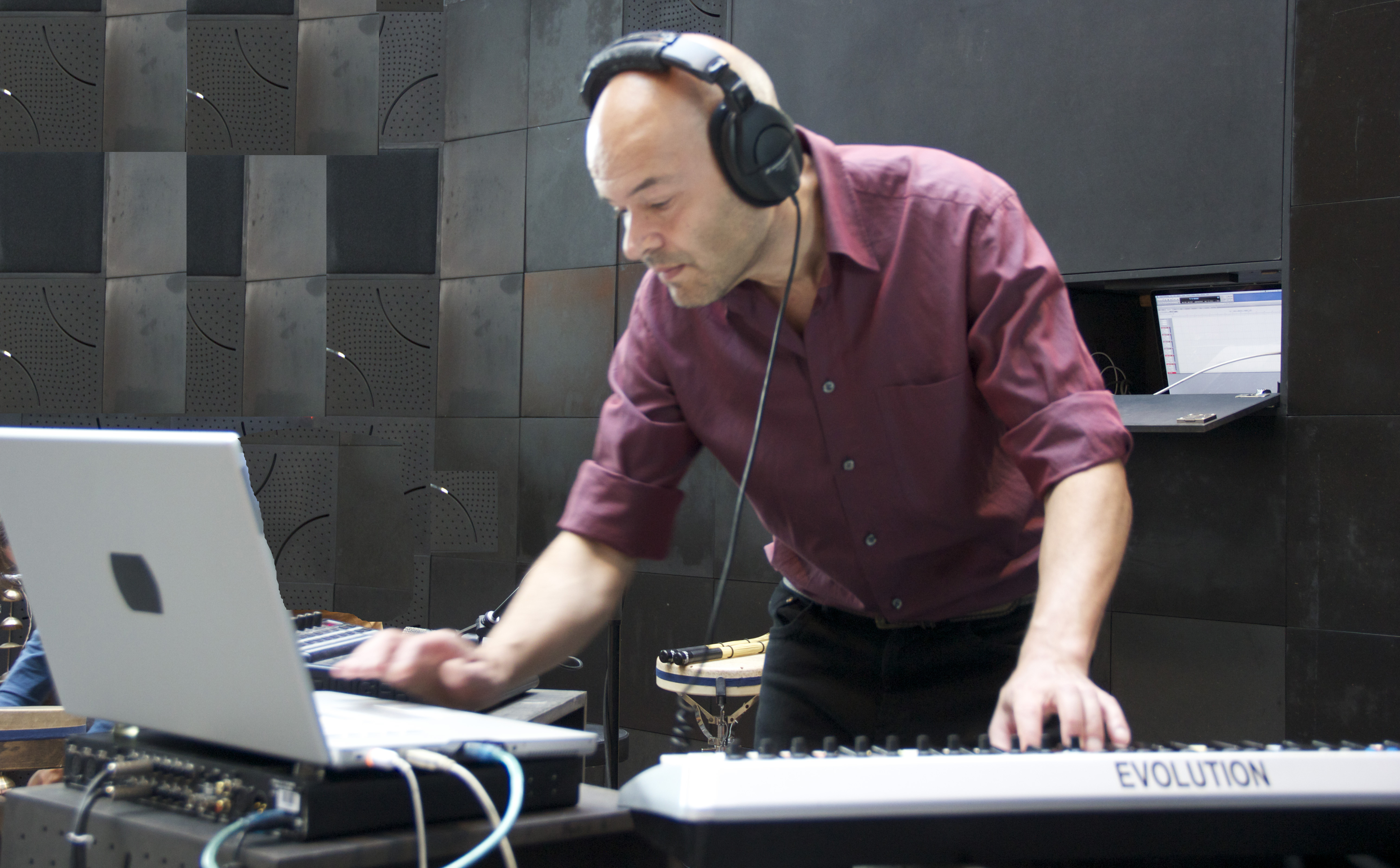 click for
hi Res
click for
hi Res
Dr. Mario Verandi
 click_for hiRes
click_for hiResMario Verandi
is an argentinean born composer and sound artist. He studied
music in Argentina and later at the Phonos Studios in Barcelona.
He continued his studies at the University of Birmingham (UK)
with Dr. Jonty Harrison and completed a Master degree and later
a PhD in electroacoustic music composition. During that time he
was active member of BEAST (Birmingham Electroacoustic Sound
Theater). In 2000 he moved to Berlin as a guest of the
Artists-in Berlin program of the DAAD (German Academic Exchange
Service). Verandis´works include electroacoustic pieces, sound
and video installations, live electronic performances and radio
art pieces. He was composer-in-residence at La Muse en Circuit
(France), the Césaré Studio (France), TU-Studios Berlin, ZKM
(Germany) and Cuenca Electroacoustic Studios (Spain). He was
guest lecturer at the Musicology Department of the Free
University Berlin in 2003. Verandi's awards include the Bourges
International Electroacoustic Art Competition (France), Musica
Nova Competition (Prague), Prix Ars Electronica (Linz),
Stockholm Electronic Art Awards (Sweden), and ZKM Commission
Competition Prize (Germany). His works have been performed
worldwide and featured at festivals such as the Kontakte
Biennale at the Academy of the Arts (Berlin), Multiphonies-GRM
(Paris), Donaueschinger Musiktage, MaerzMusik (Berlin), Futura
(France), Stockholm Electronic Art Festival,
Transmedia-Rencontres Paris/Berlin, and Interactive Futures
(Canada).

 click for
hi Res
click for
hi ResConcert program:
"Bellscape"
(acousmatic music, produced at the ZKM studios, Kahrlsruhe)
"unlike-untold"
(acousmatic music,
produced at the GRM Studios, Paris)
"Klang-Film"
(audiovisual piece, produced at the Technische Universität, Berlin)
"Plastic Water"
(acousmatic music,
produced at the Technische Universität, Berlin)
Program
Notes: “Bellscape” (2004, rev. 2018) This piece aims
to explore the spectral and morphological
(i.e. the manner in which the sound changes through time)
characteristics of
bell sounds as well as their manipulation and
transformation through the use of
computer software. Premiere: European Bell Days Festival, Kubus
at the ZKM, Karlsruhe, "unlike-untold" (2010) …different,
distinct, contrasting, dissimilar, not like … The title of the piece refers to
sound materials obtained as a result of the processing and
manipulation of a
wide variety of sound sources. It also refers to a musical
narrative that
evolved from these distinct sound materials; a narrative
that could not have
been imagined before the sound transformation process.
Produced at the
GRM-Studios in Paris. Premiere: Multiphonies
GRM
Concerts, Maison de Radio France, Salle
Olivier Messiaen, Paris "Klang-Film" (2005, audiovisual version) The film Arbeiter Verlassen die Fabrik
(Workers leaving the factory)
by Harun Farocki set the starting
framework for the creation of this audiovisual piece. The
original film was
edited by Harun Farocki and myself in order to create a
shorter version that
would suit my musical ideas. The original soundtrack
contains the voice of a
speaker describing and reflecting on the images shown.
Most of the spoken texts
were edited out and only a few left. Therefore the film
shown in this
performance becomes essentially a silent movie. This
allows the incorporation
of music as a new, influential and shaping element that
opens up a new
dimension for the perception of the visual sequences. The
aim was to create a
music that works as a parallel entity to the film and yet
is inspired and
structured by the film. The sound material includes a wide
range of real sounds
that were heavily manipulated and processed in such a way
as to generate a
specific sound palette. Premiere: Inventionen
Festival at the Sophiensälle, Berlin. "Plastic Water" (2001,
8-channel) The sounds used in this composition are
recordings of water sounds
and different improvisations played on a plastic bottle,
squashing and crushing
it in such a way as to produce different rhythmic
sequences. Those original
sounds were edited, processed, and combined with
additional abstract material
that was generated through spectral manipulations and time
expansion
/compression techniques. The sounds were then positioned
and made to move
through space using the Sigma 1 (APB Tools Berlin) System
available at
TU-Studios Berlin. The
piece was
produced at the Electroacoustic Music Studios in the
Berlin Technical
University. Premiered at Klangwerkstatt Festival at
Künstlerhaus Bethanien,
Berlin
Another important compositional element was sound
spatialisation or the
placement and movement of sounds in space. Bells are often
heard in open spaces
and therefore parameters such as distance (near and far),
loudness and decay
time were incorporated in this piece. Sound sources for
this composition are
mainly recordings of the Carillon at the Haus der Kultur
der Welt in Berlin.
Additional sources include bell recordings made in
Barcelona, Berlin and at the
University of Birmingham (UK). Bellscape
was composed during a residency at the ZKM studios in
Karlsruhe.
… unimaginable, unknown, undreamed of, not revealed,
hidden …
The main
area of exploration is the sensory
counterpoint of sounds and images and their interaction,
ambiguity and
friction. How does a particular music shape the perception
of images?. How do
images shape the perception of a particular music?. In his
book “Audio-Vision:
Sound on Screen” Michel Chion suggests that sound and
image are always
independent, and it is simply our conditioning and use of
conventions of
synchronization that make us believe that they are not.
I believe
the French filmmaker Robert
Bresson provides us with an illuminating metaphor: “Images
and sounds, like
strangers who make acquaintance on a journey and
afterwards cannot separate”.